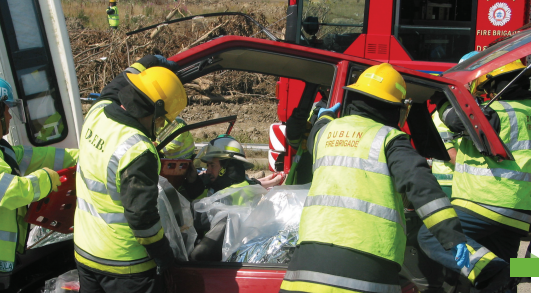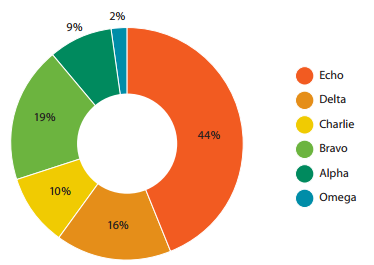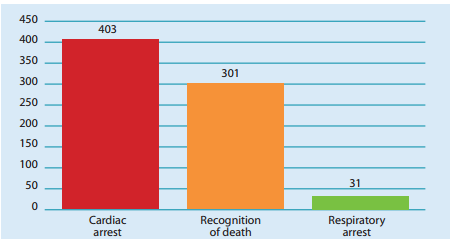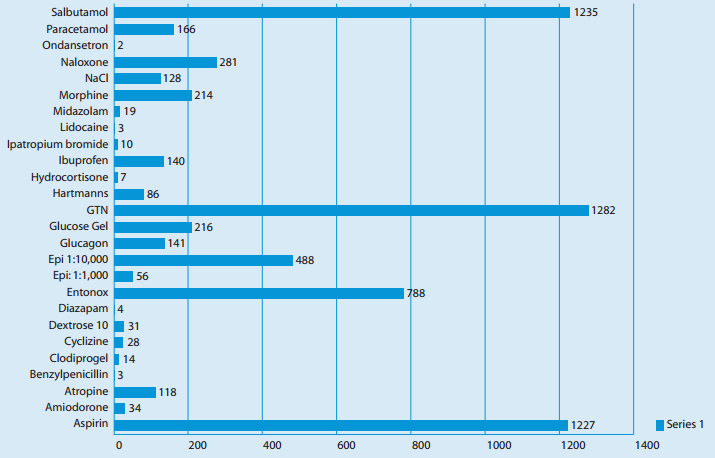Clinical Audit in DFB EMS
Clinical audit is an essential and integral part of clinical governance. It can be defined as a quality improvement process that seeks to improve patient care and outcomes through systematic review of care against explicit criteria and then implement change.
Clinical audit in Dublin Fire Brigade covers specific operational and clinical processes. The areas reviewed include EMS activity. Call taking and Advanced Medical Priority Dispatch, Response times and Patient Care Reporting. To date Dublin Fire Brigade has completed and reported on three years of audit commencing in 2009. A few examples of the type of data that can be extracted from the audit process are shown below. (Continued in next column...)
|
|
A full audit report is more extensive and can be of use as a tool for a number of resource, logistics and training purposes. It is best practice to use an audit process for service improvement keeping in mind that it is necessary to have hierarchal support and resources available to implement required change.  |

|
History
Dublin Fire Brigade Ambulance service (DFB) is one of the oldest ambulance services in the world. In 1899 there were 520 calls attended by a DFB ambulance and today it attends approximately 72,000 incidents annually.DFB has an added advantage when attending EMS incidents. When necessary, a fire appliance or other specialist vehicle may also be deployed to an incident. Each fire tender has fully trained Paramedics that are often the first on scene in echo and delta designated calls and act as first responders. In many instances the fire crew initiates first interventions which aid in reducing time to defibrillation, assisting with resuscitation, reducing on-scene time and ensuring good patient handling and packaging. Fire crews especially benefit good patient handling and a full team approach at road traffic collisions and are vital in vehicle stabilisation, immobilisation and management of spinal injury patients. An added bonus of combined fire and EMS system is extra equipment in ensuring scene safety and extrication equipment where patients are entrapped.
|
|
|
EMS Activity In 2011(AMPDS) Incidents* and Mobilisations^
| Incidents |
|
Number of EMS Incidents (DA)
|
72,261 |
Mobilisations to Incidents
|
|
Number of EMS Mobilisations
|
93,243 |
| Number of Fire Appliance Mobilisations to DA incidents |
12,381 |
* An EMS incident is where at least one EMS resource (Ambulance, Fire Appliance or Advanced Paramedic Unit) is dispatched in response to a 999/112 call.
^ Mobilisations are the number of vehicles; Fire appliances, Ambulances etc. dispatched to incidents.
The PHECC Medical Advisory Group has developed the EMS Priority Dispatch Standard
The AMPDS code is used to assist in determining dispatch priorities.There are a number of exceptions to this general classification, where the call is categorised as a higher priority than indicated in this table. The Dispatch Cross Reference (DCR) table, developed by PHECC, assigns a response to all AMPDS codes.
|
Call Taking and Advanced Medical Priority Dispatch
Calls received by the Eastern Regional Control Centre for emergency medical assistance in the Dublin Fire Brigade operational area (DA service code) are generally coded using the ProQA Advanced Medical Priority Dispatch System (AMPDS) codes.
|
|
Breakdown of 2011 Incidents of AMPDS Coded incidents using the PHECC EMS Dispatch Standard (Dispatch Cross Reference) adjusted table

% Incidents coded per AMPDS catagory ref PHECC EMS Priority Dispatch Standard
Echo coded calls received the highest priority and received a fire appliance response, in addition to an emergency ambulance and an Advanced Paramedic response, where available.
|
Response Time
The figures below are based on the Health Information and Quality Authority (HIQA) parameters for Response time – from the time of verification of chief complaint to the time a resource is in attendance
Response Time
|
|
First Response < 8Mins
|
| |
|
% where in attendance times are available |
| Echo Coded incidents (DFB |
|
70 % |
First On Scene Echo Coded Incidents
When an ambulance or fire appliance arrives in attendance at an incident the time is recorded by way of status messages sent back to the Control Centre. In order to determine which appliance (ambulance or fire appliance) arrived first at the scene at Echo coded incidents it was necessary to have times recorded for both. Of a sample of 546 such incidents: a fire appliance arrived on scene first in 58% incidents and an ambulance crew were first on scene in 42% incidents.
First on Scene Echo Coded Incidents Jan 11 to 31 Dec
Echo coded incidents
The dispatch protocol requires Echo coded (Life threatening – Cardiac or respiratory arrest) to be given the highest response priority
|
Patient Care Reporting
MAJOR CLINICAL EVENTS
Analysis of the PCR data indicated that during the audit period indicates that DFB practitioners managed 403 cardiac arrests, 31 respiratory arrests and practitioners. recognised death in 301 incidents.
Data under the heading of “cardiac arrest” was entered into a database used for the national “Out of Hospital Cardiac Arrest Register”.
|
|
 |
Medication Administration
Of the 4,501 PCRs examined, there were 6,721 administrations of medications. The following table indicates the range and extent of medications administered in the cases examined.

Pre Hospital Delivery
There were 1,689 incidents with the chief complaint heading of Pregnancy/Childbirth/Miscarriage by the Eastern Region Control Centre. Of these 1,280 were applied an AMPDS code indicating that child-birth may be imminent. During the period of the audit there were 31 pre hospital childbirth deliveries documented which equates to 2.4%.
|
|
Future Audit
The intention is to continue with and expand on this activity into the future and to work in conjunction with the HSE Medical Directorate towards a national clinical pre-hospital emergency care clinical audit policy, with agreed processes and targets. |